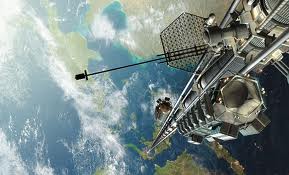At about the age of ten my favourite author was a French writer Jules Verne. His books were usually combinations of adventure and science fiction and in his work, Verne introduced to the world many interesting ideas and inventions that would eventually become true. There are probably few people in the western world who, didn’t come across his work in some form. Would it be an actual book or one of numerous movie adaptations of his books. There are other sci-fi writers who’ve managed to predict an invention or come up with an idea, that would one day materialize. Arthur C. Clark is one them and one of his idea, or more specifically, idea which he introduced to a broader audience might see the light of day in near future. It’s called a Space Elevator. That is the power of this genre, to tell a gripping, unconventional and thought provoking story, while breaking new frontiers. Sci-fi genre fascinates me to this day and occupies big part in my movie and book collection.
Having said that, it’s probably no surprise, that one of my favourite items in Smith’s curriculum is ‘Let’s Talk – The Future’. In this topical lesson students are encouraged to discuss many interesting issues that have something to do with the future of people, the earth, technology etc. This lesson is more suited to high level students as some questions can be quite challenging to discuss. For example : ‘How will everyday life change in the future? ( think of transport, shopping, the way of living…)’ or ‘Do you think that human body will eventually change in any way?’…
Smith’s Kyobashi(スミス 英会話 京橋) is only ten minutes away from OBP(Osaka Business Park) and there are many major technology, electronics and research companies situated in this area. Hence a lot of our students work in different fields which are strongly relevant to the subject of future. So to listen to and participate in the English conversation with them on this subject can be quite interesting and mind stimulating.
And last week (Feb 22) it was with a big excitement to read about the bold statement by a Japanese company ready to build a Space Elevator by 2050. The idea is an elevator link between the earth and orbiting satellite-‘counterweight’. The concept of Space Elevator, sometimes referred to as a Skyhook has been around for a long time, but due to many technical issues, couldn’t be pursued. The main problem is that a ‘cable’ or a ‘link’ connecting the earth and satellite must have enormous strength. Strength that is impossible to achieve with today’s materials. But thanks to the ‘carbon nanotube‘ technology research, the main issue with the concept seem to be solved. Scientist are convinced that this technology is the right way to go.
The company behind the project is Obayashi Corporation, whose last project was a currently finished Tokyo Sky Tree. One of the tallest standing structures in the world. They’ve also built the Dubai Metro among many other large scale constructions. Let’s see if they can pull this one off.
Why is it important?
At the moment everything and everyone we send into the space is thanks to the help of rocket power. Using rockets to send cargos into orbit is extremely expensive and dangerous. There is also huge air pollution involved.
These three major factors would be eliminated by a Space Elevator.
What are the implications?
1. More satellites in the orbit. As an expense to take satellites ‘up’ is vastly lowered, many companies involved in GPS, television, weather, geography, research etc. would be able to provide more accurate, cheaper and frequent services.
2. Manufacturing in zero-g environment. This field has a great potential in terms of producing new materials and products. But again, is too expensive for manufacturers to pursue at the moment.
3. Space tourism. No rockets equals cheaper tickets to the orbit. Simple math.
4. Moon exploration and eventual colonization. With the ability to ship enormous cargos out of earth’s gravity field, think how much resources and material can be prepared for team of astronauts, to be able to go to the moon and stay for as long as needed.
There are many other applications for this technology and I’m sure we’ll read about them in years to come. I just wanted to tell you about my excitement with this news and I’m also going to share it with students next time I’ll be coaching an Smith’s English conversation(英会話) item ‘The Future’.

Leave a Reply